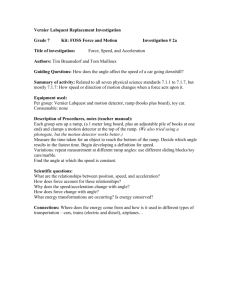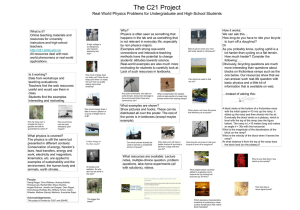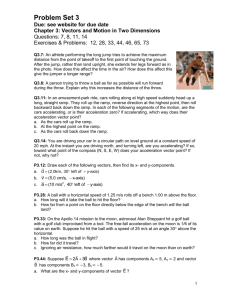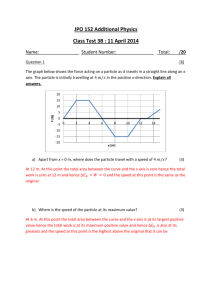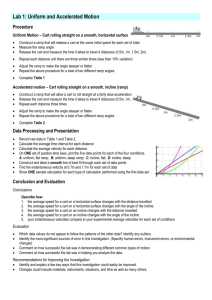Student Activity DOC
advertisement
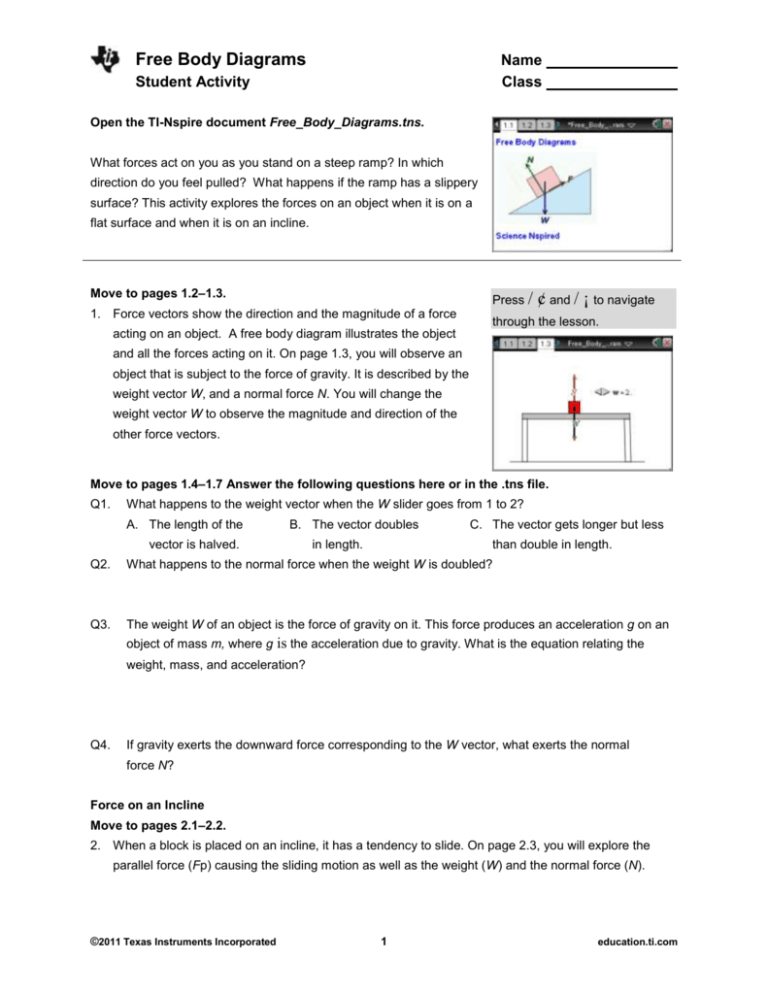
Free Body Diagrams Name Class Student Activity Open the TI-Nspire document Free_Body_Diagrams.tns. What forces act on you as you stand on a steep ramp? In which direction do you feel pulled? What happens if the ramp has a slippery surface? This activity explores the forces on an object when it is on a flat surface and when it is on an incline. Move to pages 1.2–1.3. Press / 1. Force vectors show the direction and the magnitude of a force ¢ and / ¡ to navigate through the lesson. acting on an object. A free body diagram illustrates the object and all the forces acting on it. On page 1.3, you will observe an object that is subject to the force of gravity. It is described by the weight vector W, and a normal force N. You will change the weight vector W to observe the magnitude and direction of the other force vectors. Move to pages 1.4–1.7 Answer the following questions here or in the .tns file. Q1. What happens to the weight vector when the W slider goes from 1 to 2? A. The length of the B. The vector doubles vector is halved. in length. C. The vector gets longer but less than double in length. Q2. What happens to the normal force when the weight W is doubled? Q3. The weight W of an object is the force of gravity on it. This force produces an acceleration g on an object of mass m, where g is the acceleration due to gravity. What is the equation relating the weight, mass, and acceleration? Q4. If gravity exerts the downward force corresponding to the W vector, what exerts the normal force N? Force on an Incline Move to pages 2.1–2.2. 2. When a block is placed on an incline, it has a tendency to slide. On page 2.3, you will explore the parallel force (Fp) causing the sliding motion as well as the weight (W) and the normal force (N). ©2011 Texas Instruments Incorporated 1 education.ti.com Free Body Diagrams Name Class Student Activity Move to page 2.3. 3. Change the angle of the ramp by grabbing the point at the end of the ramp. Grab the point by clicking and holding until the hand closes. Drag the point up to 90° and observe the effect on the vectors for weight, W, normal force, N, and parallel force, Fp. Move to pages 2.4–2.11. Answer the following questions here or in the .tns file. Q5. Does the normal force increase or decrease as the incline becomes closer to vertical? A. increases C. stays the same B. decreases D. cannot be determined Q6. How is the parallel force related to the normal force and the force of gravity? Q7. Given the information for the right triangle, how would you determine side Fp from the given side and angle? Q8. Given the information shown for the right triangle, how would you determine side Fp? Q9. Write the equation for the parallel force (y) for an angle of and a weight (w). y = _________________ Q10. If the Weight force is 5.0 N and the angle is 30 degrees, what is the Force parallel? Q11. What angle is needed to produce a parallel component of 2.50 N for a weight of 6.00 N? ©2011 Texas Instruments Incorporated 2 education.ti.com Free Body Diagrams Name Class Student Activity Friction Force on an Incline Move to page 3.1. 4. How does friction affect how the block slides down the ramp? On page 3.2 you will look at the relationship between the friction, parallel force, normal force, and weight. Move to page 3.2. 5. Change the angle of the ramp by grabbing the point and raising the ramp. The sliding block will be traveling in a positive direction as it slides down the ramp. Observe the forces, Ff, Fp, N and W. Move to pages 3.3–3.9. Answer the following questions here or in the .tns file. Q12. What vectors appeared when the angle became greater than zero? Q13. The block will slide down the ramp when _______. A. Ff > Fp C. Fp < Ff B. Ff = Fp D. cannot be determined above Q14. What does Ff stand for, and why is it in the opposite direction of Fp? Q15. The net force causing acceleration down the ramp is equal to _______. A. Ff + Fp C. Fp – Ff B. Ff – Fp D. none of the above Q16. If the friction force is 1.0 N and the weight of the object is 3.0 N, at what angle will the block slide? Q17. What is the magnitude of the parallel force for the data shown? Q18. What is the magnitude of the normal force for the data shown? Move to pages 3.10–3.11. The sliding force is equal to the sum of all forces. When the block slides down a ramp, it has overcome the friction force and begins to accelerate down the ramp. Q19. What is the magnitude of the sliding force for the data shown? ©2011 Texas Instruments Incorporated 3 education.ti.com
